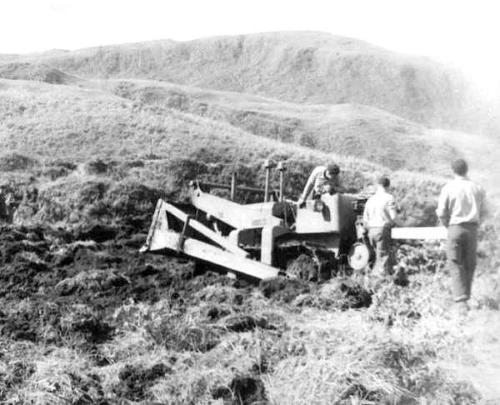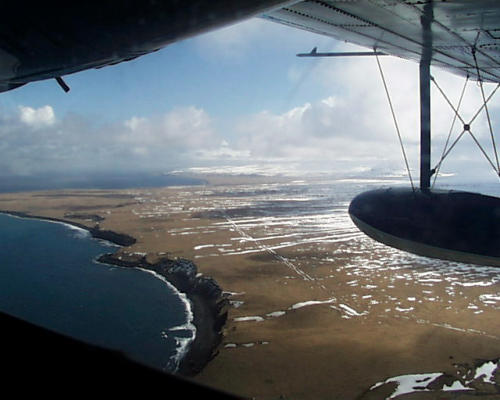
Umnak, Aleutian Islands, Alaska






There's a Fighter Base Located Where?
In 1941 General Buckner, to bypass heavy U. S. Navy opposition to U. S. Army involvement in the Aleutians that
would appear to subvert the Navy's interests there (the Navy considered this to be "their turf"), covertly contrived
the "Blair Fish Packing Co," an outfit whose real intentions were to build a U. S. Army Air Force base on the island
of Umnak. After lengthy and intense negotiations with General DeWitt, General Buckner finally received official
approval for his plans to build airbases at both Cold Bay and Umnak. The fish packing company cover was retained
to help conceal the United States effort to establish forward air bases in the Aleutians from which to protect Dutch
Harbor and to launch attacks against the Japanese. In March of 1942, the 807th Army Engineers arrived in the
Aleutians to begin work on the airfields.
Umnak is part of the "Fox" islands grouping, southwest of mainland Alaska in the Aleutian chain. It is the third
largest of the Aleutian islands, having a land mass of around 675 square miles. At this time in it's history, Umnak
supported about 50 Aleut residents, about 15,000 sheep, and a heard of imported reindeer. Umnak has no natural
harbor, supports no trees, and is very mountainous. There were serious doubts that a runway could in fact be
constructed here. General Buckner solved the runway problem by importing to Umnak 3,000,000 square feet of
Marsden Matting, perforated-steel plating (PSP) that could be assembled with other steel plates to create a flat
surface upon which aircraft could take off and land. On March 31st, 1942 the 807th had completed the 3,000 by 100
foot runway on Umnak for use by Jack Chenault's P-40 fighter aircraft.
The joint Board in late November 1941 had approved the construction of an Army airfield on Umnak Island, not
only to provide local air protection for the naval base at Dutch Harbor, but also for the broader purposes of
blocking a Japanese advance toward the mainland and permitting the projection of Army air power into the more
distant Aleutians. Army Engineers under the command of Col. Benjamin B. Talley began the construction of a
runway at Otter Point on the northeastern end of Umnak in mid-January 1942 and soon thereafter undertook
similar work on an intermediate base at Cold Bay near the tip of the Alaska Peninsula, where construction of an
airfield had been started by the Civil Aeronautics Administration. The Umnak base became the Army's Fort Glenn,
and the Cold Bay base Fort Randall, with Fort Mears, the Army garrison for Dutch Harbor, in between. Both of the
new fields were usable by 1 April, although just barely so. When the enemy approached two months later, Umnak
had a garrison of about 4,000, Fort Mears of over 6,000, and Cold Bay of about 2,500, including engineer troops, but
also including balanced complements of infantry and of field and antiaircraft artillery units. Generals Buckner and
DeWitt had wanted a much larger combat force for the forward base on Umnak but had to be content with the
2,300 or so combat troops that the War Department had authorized.
While the Umnak and Cold Bay airfields were being rushed to completion, the Japanese High Command was
planning to attack and occupy points in the Aleutian Islands as part of their "second phase" offensive. By April
Japanese planners had agreed on the main features of the operation. Japanese task forces were to undertake a
two-pronged drive against Midway and the Aleutian Islands in the early part of June. Aside from its diversionary
aspect to cover the Midway strike, the Aleutian phase of the operations was to be purely defensive. After capturing
Midway and Kiska, the Japanese intended to use them as bases for an aerial patrol of North Pacific waters. The
islands would also be outposts in a new defense perimeter that would be extended in due course to the Samoan
and Fiji Islands and New Caledonia.
The enemy knew little of American activities in the Aleutians since the war's beginning. The Japanese planners
thought the United States had extensive military installations at Dutch Harbor and smaller garrisons on Adak,
Kiska, and Attu. They also believed that there were one or two small aircraft carriers as well as cruisers and
destroyers operating in Aleutian waters. But they knew nothing of the new airfields east and west of Dutch Harbor
then nearing completion.

1943 Umnak: Dozer stuck in the Tundra (Don Blumenthal)

Umnak’s Ft. Glenn & Cape Field (Ed Sidorski)
National Park Service: Ft. Glenn, located on Umnak Island, Alaska, remains the most comprehensive and intact
WWII base in the Aleutian Islands. It was designated a National Historic Landmark on 28 May 1987. Ft. Glenn was
decommissioned in 1950, after having provided aerial defensive cover for the U. S. Bases in Unalaska Bay (Dutch
Harbor) during the early days of WWII in the Aleutians. Ft. Glenn was constructed between January and April 1942,
with its Cape Field runway then being the U. S. Army’s most westerly airfield in the Aleutian Islands. Fighter pilots
stationed at Ft. Glenn led the counterattack against Japanese pilots that were bombing Dutch Harbor on the 3rd
and 4th of June, 1942. Ft. Glenn also served as the initial forward base to launch bombing attacks on Japanese
installations at Attu and Kiska.
Visit our Links and Scrapbook pages for more of the story….
Page Last Updated: 02/12/2022 15:12
Site Last Updated: 05/13/2018 09:53
First Published: 07/07/2005
Version: Umnak_Vs20180513_0905

Umnak, Aleutian Islands, Alaska






There's a Fighter Base Located Where?
In 1941 General Buckner, to bypass heavy U. S. Navy opposition to U. S. Army involvement in the Aleutians that
would appear to subvert the Navy's interests there (the Navy considered this to be "their turf"), covertly contrived
the "Blair Fish Packing Co," an outfit whose real intentions were to build a U. S. Army Air Force base on the island
of Umnak. After lengthy and intense negotiations with General DeWitt, General Buckner finally received official
approval for his plans to build airbases at both Cold Bay and Umnak. The fish packing company cover was retained
to help conceal the United States effort to establish forward air bases in the Aleutians from which to protect Dutch
Harbor and to launch attacks against the Japanese. In March of 1942, the 807th Army Engineers arrived in the
Aleutians to begin work on the airfields.
Umnak is part of the "Fox" islands grouping, southwest of mainland Alaska in the Aleutian chain. It is the third
largest of the Aleutian islands, having a land mass of around 675 square miles. At this time in it's history, Umnak
supported about 50 Aleut residents, about 15,000 sheep, and a heard of imported reindeer. Umnak has no natural
harbor, supports no trees, and is very mountainous. There were serious doubts that a runway could in fact be
constructed here. General Buckner solved the runway problem by importing to Umnak 3,000,000 square feet of
Marsden Matting, perforated-steel plating (PSP) that could be assembled with other steel plates to create a flat
surface upon which aircraft could take off and land. On March 31st, 1942 the 807th had completed the 3,000 by 100
foot runway on Umnak for use by Jack Chenault's P-40 fighter aircraft.
The joint Board in late November 1941 had approved the construction of an Army airfield on Umnak Island, not
only to provide local air protection for the naval base at Dutch Harbor, but also for the broader purposes of
blocking a Japanese advance toward the mainland and permitting the projection of Army air power into the more
distant Aleutians. Army Engineers under the command of Col. Benjamin B. Talley began the construction of a
runway at Otter Point on the northeastern end of Umnak in mid-January 1942 and soon thereafter undertook
similar work on an intermediate base at Cold Bay near the tip of the Alaska Peninsula, where construction of an
airfield had been started by the Civil Aeronautics Administration. The Umnak base became the Army's Fort Glenn,
and the Cold Bay base Fort Randall, with Fort Mears, the Army garrison for Dutch Harbor, in between. Both of the
new fields were usable by 1 April, although just barely so. When the enemy approached two months later, Umnak
had a garrison of about 4,000, Fort Mears of over 6,000, and Cold Bay of about 2,500, including engineer troops, but
also including balanced complements of infantry and of field and antiaircraft artillery units. Generals Buckner and
DeWitt had wanted a much larger combat force for the forward base on Umnak but had to be content with the
2,300 or so combat troops that the War Department had authorized.
While the Umnak and Cold Bay airfields were being rushed to completion, the Japanese High Command was
planning to attack and occupy points in the Aleutian Islands as part of their "second phase" offensive. By April
Japanese planners had agreed on the main features of the operation. Japanese task forces were to undertake a
two-pronged drive against Midway and the Aleutian Islands in the early part of June. Aside from its diversionary
aspect to cover the Midway strike, the Aleutian phase of the operations was to be purely defensive. After capturing
Midway and Kiska, the Japanese intended to use them as bases for an aerial patrol of North Pacific waters. The
islands would also be outposts in a new defense perimeter that would be extended in due course to the Samoan
and Fiji Islands and New Caledonia.
The enemy knew little of American activities in the Aleutians since the war's beginning. The Japanese planners
thought the United States had extensive military installations at Dutch Harbor and smaller garrisons on Adak,
Kiska, and Attu. They also believed that there were one or two small aircraft carriers as well as cruisers and
destroyers operating in Aleutian waters. But they knew nothing of the new airfields east and west of Dutch Harbor
then nearing completion.

1943 Umnak: Dozer stuck in the Tundra (Don Blumenthal)

Umnak’s Ft. Glenn & Cape Field (Ed Sidorski)
National Park Service: Ft. Glenn, located on Umnak Island, Alaska, remains the most comprehensive and intact
WWII base in the Aleutian Islands. It was designated a National Historic Landmark on 28 May 1987. Ft. Glenn was
decommissioned in 1950, after having provided aerial defensive cover for the U. S. Bases in Unalaska Bay (Dutch
Harbor) during the early days of WWII in the Aleutians. Ft. Glenn was constructed between January and April 1942,
with its Cape Field runway then being the U. S. Army’s most westerly airfield in the Aleutian Islands. Fighter pilots
stationed at Ft. Glenn led the counterattack against Japanese pilots that were bombing Dutch Harbor on the 3rd
and 4th of June, 1942. Ft. Glenn also served as the initial forward base to launch bombing attacks on Japanese
installations at Attu and Kiska.
Visit our Links and Scrapbook pages for more of the story….















